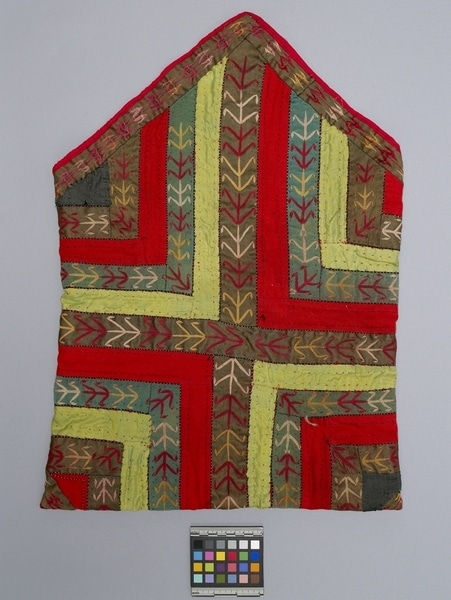Bag Item Number: 916/3 from the MOA: University of British Columbia


Description
Large, square, flat envelope style bag made of a cotton patchwork textile with multi-coloured embroidered trim. The patchwork- made of red, yellow-green, green and brown strips- forms a pattern of concentric squares; alternate strips are embroidered in ladder stitch, using red, yellow and pale pink floss. The bag is made by folding and stitching three corners of the patchwork square together, leaving the fourth corner open as a flap. The seams that join the three corners are reinforced with embroidered motifs. The patchwork textile is quilted onto a finely-striped dark blue and tan cotton textile. No provision is made for fastening the flap.
History Of Use
The seller indicated that this bag was meant to hold a Qur'an (Koran). Could also have been used to carry important documents, etc. Textiles used to make the patchwork may have been recycled from other projects, or were scraps left over from other projects, a common practice.
Narrative
According to Clarke Abbott of Tradewind Antiques, the person who collected this piece lived in Kabul in the early 1960s, doing ambassadorial work. He traveled widely throughout the area. He was killed in an automobile accident there, and no further information is available about him or his collection. The piece was subsequently acquired by Tradewind Antiques in Vancouver at an unknown date, and the Museum of Anthropology purchased it in 1984, when the business was liquidating its stock. Clarke Abbott, from whom the textile was purchased, indicated that this piece is Turkmen; however, this could not be confirmed. The provenance of this piece is unknown. It may have been collected in Afghanistan, where the collector lived for a time in the 1960s. Textiles used to make the patchwork may have been recycled from other projects, or were scraps left over from other projects, a common practice.
Item History
- Made in Afghanistan before 1965
- Collected in Afghanistan ?
- Owned by Tradewind Antiques before January 10, 1984
- Received from Museum of Anthropology Shop Volunteers (Funding source) and Tradewind Antiques (Seller) on January 10, 1984
What
- Name
- Bag
- Identification Number
- 916/3
- Type of Item
- bag
- Material
- silk fibre, dye and cotton fibre
- Manufacturing Technique
- quilted and embroidered
- Overall
- height 56.5 cm, width 40.8 cm, depth 2.7 cm
Who
- Culture
- Turkmen ?
- Previous Owner
- Tradewind Antiques
- Received from
- Museum of Anthropology Shop Volunteers (Funding source) and Tradewind Antiques (Seller)
Where
- Holding Institution
- MOA: University of British Columbia
- Made in
- Afghanistan
- Collected in
- Afghanistan ?
When
- Creation Date
- before 1965
- Ownership Date
- before January 10, 1984
- Acquisition Date
- on January 10, 1984
Other
- Item Classes
- textiles
- Condition
- excellent
- Accession Number
- 0916/0003